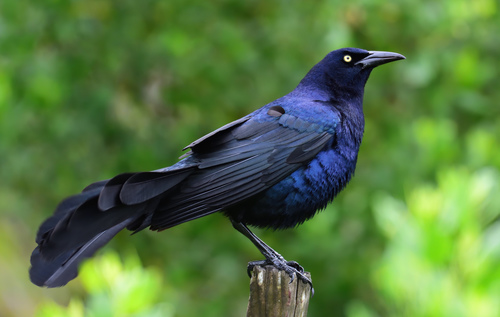
Great-tailed Grackle
The Great-tailed Grackle (Quiscalus mexicanus) is a large, conspicuous passerine bird native to North and South America. Known for its striking sexual dimorphism, with males exhibiting iridescent black plumage and long, keel-shaped tails, and females having a smaller size, brown plumage, and a shorter tail. This highly adaptable species thrives in a variety of habitats, often near human settlements. They play a significant role in seed dispersal and insect control, and their boisterous calls and large communal roosts are a familiar sight and sound in many areas. In some pre-Columbian cultures of Mexico, the Great-tailed Grackle was associated with deities of agriculture.
38-46 cm
Length
48-58 cm
Wingspan
Least Concern
Conservation Status
Distribution
The Great-tailed Grackle's range extends from the southwestern United States (California, Arizona, New Mexico, Texas) through Mexico and Central America, reaching northern South America (Colombia, Venezuela, Ecuador, and northwestern Peru). They have been expanding their range northward in recent decades. Altitudinally, they range from sea level to over 2,500 meters.
Lifespan
Typically 6-8 years in the wild, although some individuals may live longer. Captive birds can live up to 12 years.
Great-tailed Grackle's Habitat
Habitat Types
Urban areas, Agricultural lands, Wetlands, Grasslands, Open woodlands, Coastal marshes
Climate Zones
Tropical, Subtropical, Temperate
Adaptations
Great-tailed Grackles are highly adaptable and opportunistic, thriving in both natural and human-modified environments. They are tolerant of a wide range of temperatures and humidity levels. Their generalist diet allows them to exploit various food resources.
Variations
Several subspecies are recognized, differing slightly in size and plumage characteristics. For instance, populations in the southwestern US are generally larger than those in Central America.
Appearance
Breeding Plumage
Adult male plumage is largely iridescent black year-round. Females are brown, darker above and paler below, with some streaking. Juvenile birds resemble females but are duller.
Seasonal Feather Changes
There is minimal seasonal variation in plumage, although males may appear slightly glossier during the breeding season.
Sex Based Plumage Differences
Highly pronounced. Males are larger and black, while females are smaller and brown.
Notable Features
Long, keel-shaped tail (especially in males), Bright yellow eyes, Strong, slightly decurved bill, Long legs
Diet and Feeding
Primary Foods
Insects, Seeds, Grains, Fruits, Small invertebrates, Occasionally small vertebrates (e.g., lizards, nestlings)
Foraging Behavior
Great-tailed Grackles are omnivorous and forage on the ground, in trees, and in shallow water. They often walk or run while foraging, probing the ground with their bills. They are also known to hawk for insects in the air and glean them from foliage.
Specializations
Their strong bill allows them to crack open seeds and manipulate a variety of food items. Their long legs are adapted for wading in shallow water.
Seasonal Diet Variations
Their diet varies seasonally depending on food availability. During the breeding season, they consume more insects, while in the non-breeding season, they may rely more on seeds and grains.
Behavior
Social Structure
Highly social, often forming large flocks, especially outside the breeding season. They roost communally, sometimes in groups of thousands of birds.
Communication
Loud, raucous calls, A variety of whistles, clicks, and chatters, Visual displays (e.g., tail spreading, feather ruffling)
Migration
Some populations are migratory, while others are resident. Northern populations tend to migrate south for the winter, while southern populations are generally non-migratory.
Territorial or Group Behaviors
During the breeding season, males establish and defend territories around nesting sites. Outside the breeding season, they are highly gregarious and form large foraging and roosting flocks.
Conservation
Threats
Habitat loss (in some areas), Pesticide exposure, Human persecution (due to perceived agricultural damage)
Protection Programs
General protections under the Migratory Bird Treaty Act (in the US)
Local National Laws
Protected under various state and national laws in the US and Mexico.
Population Trend
Increasing
Population Estimates
Global population estimated to be in the tens of millions.
Interesting Facts
Great-tailed Grackles are known for their intelligence and adaptability.
They have been observed using tools (e.g., dropping hard food items onto hard surfaces to break them) and adapting to a wide range of human-altered environments.
They are one of the few bird species that have expanded their range significantly in recent decades.
This expansion is likely due to their ability to thrive in human-modified landscapes and their high reproductive rate.
Their large roosts can be incredibly noisy and create significant mess.
This can sometimes lead to conflicts with humans.
The male Great-tailed Grackle's tail can be almost as long as its body.
This impressive tail is used in courtship displays and helps distinguish them from other grackle species.
Faqs about Great-tailed Grackle
What do Great-tailed Grackles eat?
They are omnivores and eat a wide variety of foods, including insects, seeds, grains, fruits, small invertebrates, and occasionally small vertebrates.
Are Great-tailed Grackles aggressive?
They can be aggressive, especially during the breeding season when defending their nests. They are also known to mob potential predators.
Why are Great-tailed Grackles expanding their range?
Their adaptability, generalist diet, and high reproductive rate have allowed them to thrive in human-modified environments and expand into new areas.
What is the difference between a male and female Great-tailed Grackle?
Males are larger, glossy black with a long, keel-shaped tail, while females are smaller and brown with a shorter tail.
Copyright @ Nature Style Limited. All Rights Reserved.
 English
English